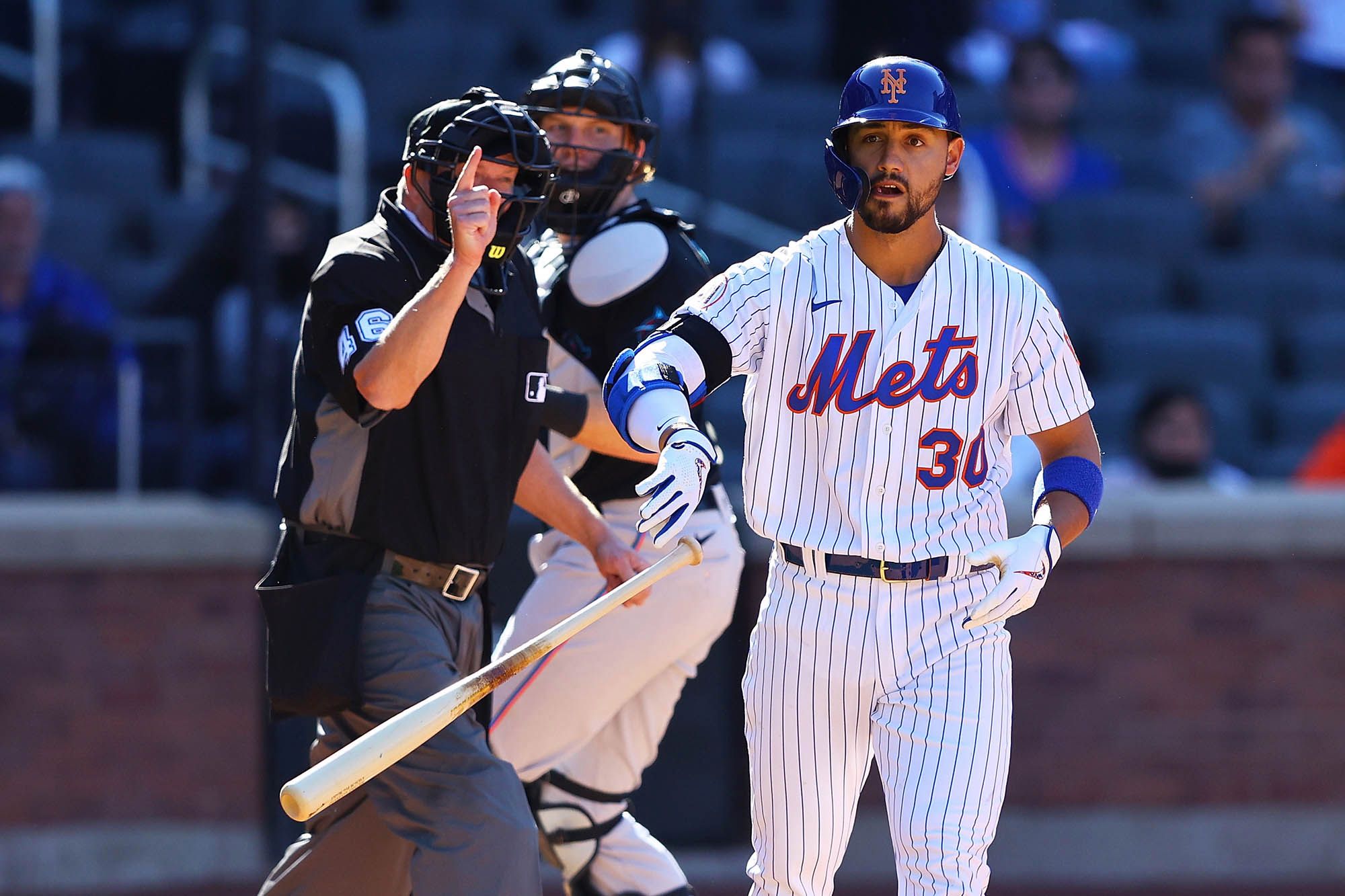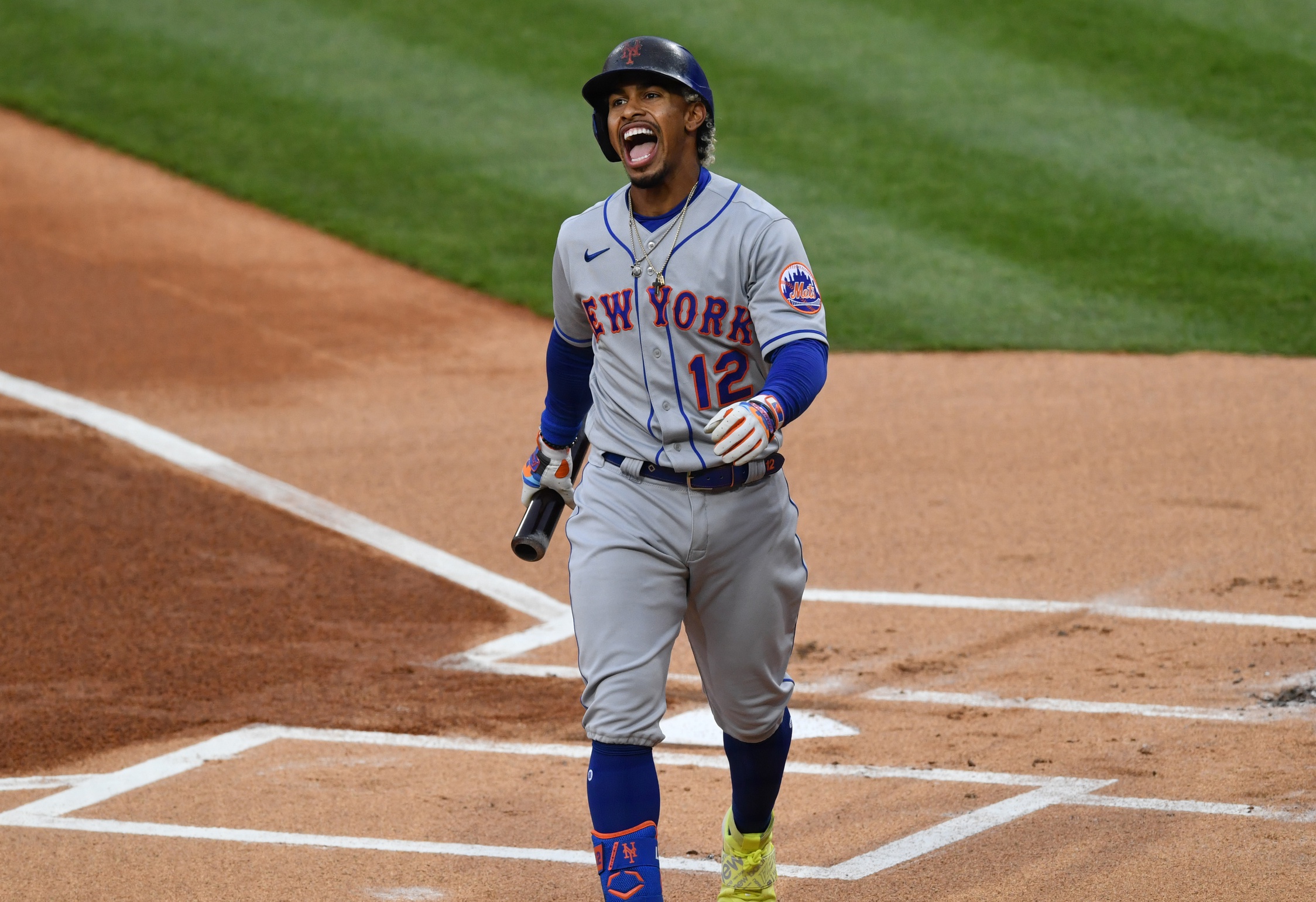
The Mets took the final two of three games from the Phillies this past weekend, getting their seven-game road trip — and May — started on the right foot.
Despite suffering what seem to be short-term injuries to Marcus Stroman, Brandon Nimmo, Edwin Diaz and J.D. Davis, the Mets finally got enough hitting to support their pitching with one-run wins on Saturday an Sunday after a one-run loss on Friday.
This series featured the introduction of Donnie Stevenson — a mythical hitting/approach coach that Pete Alonso brought up (and most likely created) in Saturday’s post-game conference. He’s the being (life form? spirit? A Pete Alonso dual personality?) that helps the Mets work on ripping heaters and getting their mind right.
Diesel Donnie for days. #LGM pic.twitter.com/1GYXO0vlbK
— John Flanigan (@JohnFlanigan_) May 3, 2021
After scoring just two runs in three games against the Boston Red Sox, the Mets combined for 13 runs in their last two games at Citizens Bank Park. Diesel Donnie brought the juice.
3 Up
Michael Conforto At The Plate
We can’t say it for the whole team, but Michael Conforto has certainly come around at the plate. The right fielder went 5-for-10 with three walks in the Phillies series and knocked in five of the Mets’ 14 runs the last three games. He’s been under-the-radar hot since April 17 — the Colorado doubleheader — as Michael Mayer points out.
Michael Conforto over his last 14 games:
.327/.400/.551, 5 2B, 2 HR, 6 RBI
— Mike Mayer (@mikemayer22) May 3, 2021
You can tell Conforto is seeing the ball well with a small drop in his strikeout rate the last two weeks, as well as the power coming back.
He had great at-bats this series. His home run Saturday (seen above) came when down in the count. During his third at-bat Sunday night, he started out 0-2 against Zach Eflin, a guy he already recorded two hits against. Conforto fouled off four pitches and worked it to 2-2 before singling to right field. He also worked a walk with the bases loaded against Jose Alvarado, albeit Alvarado didn’t make that too hard.
Dominic Smith seemed to inch things in the right direction this series by going 5-for-13 over the three games, too, as did Jeff McNeil (4-for-11 and two walks and a total of 8-for-22 since April 23). We’ll wait another series or two before declaring they’ve righted the ship, though.
Perhaps Donnie Stevenson — who I’m already predicting will become Dinger Donnie once they start hitting home runs — actually lit a fire under a couple of Mets hitters.
David Peterson‘s Strikeout Rate
David Peterson has had a couple of innings get away from him this year, resulting in a 4.81 ERA in 24.1 innings.
The 25-year-old has seen a spike in his strikeout rate through his first five starts, though, jumping from 19.5 percent in 2020 to 29 percent this year. He’s putting away batters more with his sinker and slider than last year, according to Statcast. It helps that he’s throwing his sinker three times as much as he did in 2020. It’s been an effective pitch (.303 wOBA) when players have made contact and as a tool to put batters away.
Peterson strikes out the side in the 2nd 🚫
(via @Mets) pic.twitter.com/p3ZIh6Jw3f
— SNY (@SNYtv) May 2, 2021
Luis Rojas noted Peterson’s improved changeup as something he’s liked from the lefty this year on a Sunday Night Baseball interview, as well. Though the spin rate, velocity and break on his changeup are all pretty similar to his 2020 numbers, he’s peppering the pitch further down and away to righties (he rarely throws it to lefties). He hasn’t allowed a hit on that pitch yet on over 60 changeups thrown and has gotten a whiff about one of every three changeups that are swung at.
Peterson was never known as a big strikeout pitcher in the minors (his highest strikeout rate was 24.6 percent in half a season of Single-A, and it dipped to below 20 percent in High-A), so this has been a nice new wrinkle to his game.
Clutchness
The Mets got wins the last two nights with clutch plate appearances from Conforto and Alonso.
Conforto’s solo home run put the Mets ahead 5-4 on Saturday, and a walk with the bases loaded from Conforto put the Mets up 5-4 again Sunday. Alonso then blew the doors open with a bases-clearing double while the Mets had a one-run lead — a moment the Polar Bear seemingly lives for.
There are also the handful of at-bats that got the Mets into position to take the lead Sunday, including José Peraza’s single off Rhys Hoskins‘ glove (which Jonathan Villar took home on when Hoskins was caught sulking) and Kevin Pillar‘s home run to pull the Mets within a run.
Conforto and Alonso’s plate appearances the last two nights are three of the biggest plate appearances the team has had this year. (Conforto’s lean-over-the-plate hit-by-pitch comes to mind, too). Perhaps they’re a sign that the April showers — both figurative and literal — will soon bloom May flowers.

Credit: Kyle Ross-USA TODAY Sports
3 Down
Francisco Lindor At The Plate
Francisco Lindor just had what was probably the worst month of his career. Naturally, it comes in the first month with his new team.
After this Phillies series, where he went 0-for-13, he’s now hitless in his last 17 at-bats. His slash line is a paltry .171/.289/.508 with a 54 wRC+.
Lindor’s biggest concern right now is there has been zero power when he does connect for a hit. He only has two extra-base hits — a double and a home run — through 82 at-bats. This is a guy who had over 40 doubles and 30 home runs each season from 2017 to 2019.
His average exit velocity currently sits at the 40th percentile in the league when in past seasons, he’s ranged between the 70th and 80th percentiles. He’s also hitting the ball on the ground more than ever (over 50 percent of the time) and is getting fewer line drives (below 15 percent this year when his career rates are between 18 and 22 percent). This shows in his average launch angle, which is currently three to four degrees below his average since 2017.
His track record shows a lot longer of a positive history than a negative one, so Lindor will turn things around and return to the above-average hitter that he is. April was a slog, though, and May could quickly turn into one, too.
Team Base Running
This winter, we wrote a handful of times about how the Mets needed to get better at base running. Some players they acquired (Lindor, Villar, Pillar) all had positive base running metrics, and they particularly had strong BsR — FanGraphs’ all-encompassing base running stat — numbers in previous seasons.
Villar’s wonderful base running to help tie the game Sunday aside, the Mets as a team aren’t faring any better on the base paths. The second inning on Sunday night highlighted that.
After a lead-off double by Dom Smith, Kevin Pillar had a chance to knock him in. Pillar did indeed single into center field, but Roman Quinn gunned Smith out at the plate. Smith took a wide turn at third and collided with J.T. Realmuto as the ball arrived. A shorter turn at third may have given Smith the couple of inches he needed to score.
While Smith was getting thrown out, Pillar never advanced from first to second on the throw home that featured a collision. Villar was at the plate next and grounded out to first. Rather than advance to third had he taken the extra base, Pillar was forced out at second. (There’s an argument to be made that Pillar didn’t advance because the cutoff man would’ve cut the ball off and thrown him out, but that would’ve allowed the run to score. It felt like a win-win situation to keep going.)
Fangraphs’ BsR numbers back up the eye test. After this series, the Mets are 27th out of 30 teams in BsR with -4.6 — a number that got significantly worse after Sunday night’s game. Smith and Pillar both have negative numbers, and James McCann currently has the worst number on the team at -2.1.
With the Mets’ struggles at the plate, the base paths are a place they can’t be losing any run value. They are right now, and that’s another area on offense where things need to tighten up.
Umpiring
There’s the ridiculousness of the double-play-that-shouldn’t-have-been from Saturday. There’s the consistent squeezing of both teams in the strike zone. (The home plate umpires combined to call just 83 percent of actual strikes as strikes on Friday). Then there was the non-home-run-called-a-home-run and a strike three on Bryce Harper that wasn’t called strike three in the ninth. And this is just in this series, with these teams.
There’s also the egregious defensive interference call against the Brewers. And then there’s this poor showing on the field from a home plate umpire in the Rays-Athletics game, who got the call wrong on a play at the plate, and then the umpire crew got it wrong on review, too. And these are just from this week.
I’m going partly off feel (and clearly some hard evidence), but the umpiring hasn’t been peachy keen this year.
—
One could say the bullpen was a down based on Sunday night alone, but they’ve really been a plus all year. They had 18 straight scoreless innings before Miguel Castro and Diaz gave up five runs Sunday. That won’t be a “down” until it becomes a “thing” over the next series or two.
The Mets are now tied for first place again ahead of a full slate of games this week. It’ll be the first bit of scheduling consistency the team has had this year.















